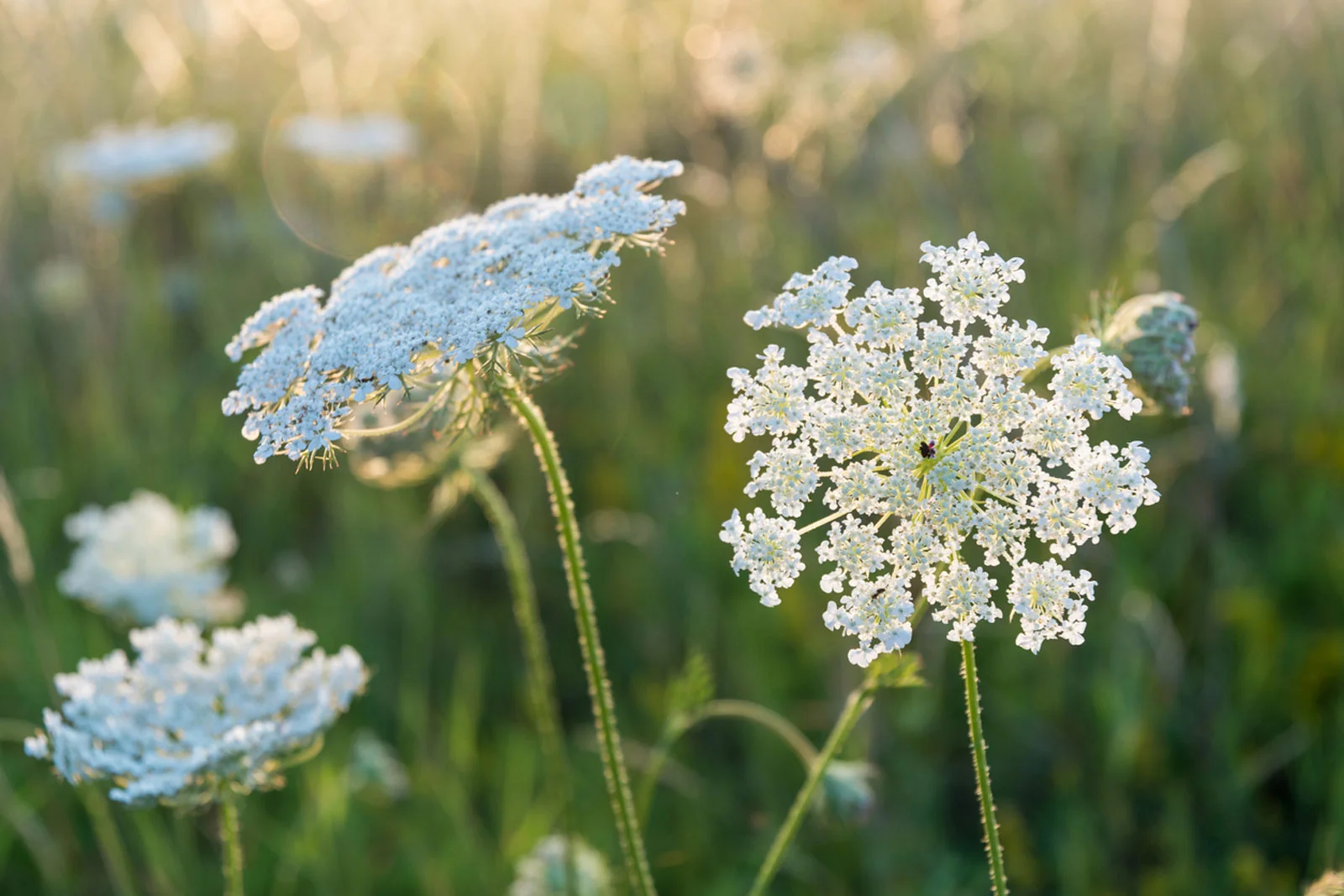
Queen Anne’s Lace, also known as Wild Carrot or Daucus carota, is a fascinating plant that can be found flourishing in fields, meadows, and roadways. Its delicate white flowers and intricate lacy leaves make it a visually stunning addition to any landscape. But Queen Anne’s Lace is more than just a pretty face – it boasts a rich history and a plethora of interesting traits. In this article, we will explore 12 fascinating facts about Queen Anne’s Lace that will surely pique your interest. So, get ready to delve into the world of this enchanting plant and discover the hidden wonders that lie within!
Key Takeaways:
- Queen Anne’s Lace, also known as “Wild Carrot,” is a delicate and versatile plant with edible roots and medicinal properties. It attracts pollinators and has cultural significance in art and literature.
- The lacy white flowers of Queen Anne’s Lace can be used in dried flower arrangements and to create natural dyes. It is important to monitor its growth to prevent it from becoming an invasive species.
Origin and Name
Queen Anne’s Lace, scientifically known as Daucus carota, is native to Europe and Southwest Asia. The name “Queen Anne’s Lace” is said to have derived from the delicate lace-like appearance of the flower clusters.
Identification
Queen Anne’s Lace is a biennial plant characterized by its tall, slender stems that can reach a height of up to three feet. The plant features finely dissected, feathery leaves and a cluster of small, white flowers in the shape of an umbrella-like canopy.
Edible and Medicinal Uses
The young roots of Queen Anne’s Lace are edible and can be cooked or eaten raw. The plant is also known for its medicinal properties and has been traditionally used to treat various ailments like urinary issues and digestive problems.
Habitat
Queen Anne’s Lace thrives in a variety of habitats including meadows, roadsides, and fields. It is known to be a hardy plant that can withstand different soil conditions and climates.
Wildlife Attraction
The nectar-rich flowers of Queen Anne’s Lace are highly attractive to a variety of pollinators, including bees, butterflies, and hoverflies. The plant also serves as a host for the larvae of some butterfly species.
Invasive Species
In certain regions, Queen Anne’s Lace has become an invasive species, as it can rapidly spread and outcompete native plants. It is important to monitor its growth and prevent its spread in sensitive ecosystems.
Symbolism
Queen Anne’s Lace is often associated with femininity, delicacy, and natural beauty. It has been used as a symbolic representation of purity and is sometimes referred to as “Wild Carrot” or “Bird’s Nest.
Cultural Significance
Throughout history, Queen Anne’s Lace has been referenced in literature, art, and folklore. It has appeared in paintings, poems, and even plays, adding a touch of elegance to various creative expressions.
Dried Flower Arrangements
The intricate, lacy appearance of Queen Anne’s Lace flowers makes them popular for drying and using in floral arrangements. Their delicate white blooms add a touch of elegance and charm to any bouquet.
Chemical Properties
Queen Anne’s Lace contains various compounds, including essential oils, flavonoids, and terpenoids, which contribute to its unique aroma and potential health benefits.
Varieties
There are several cultivated varieties of Queen Anne’s Lace that feature different flower colors, including pink, purple, and even red. These variations add diversity to gardens and landscapes.
Natural Dye
The flowers of Queen Anne’s Lace can be used to create natural dyes, producing soft shades of yellow or green. This has been historically used in textile and fabric dyeing processes.
Conclusion
In conclusion, Queen Anne’s Lace is a fascinating plant that has captivated people for centuries. Its delicate white flowers, intricate lace-like patterns, and medicinal properties make it a highly esteemed plant in the world of botany. Whether you appreciate its beauty, use it for herbal remedies, or simply want to learn more about nature’s wonders, Queen Anne’s Lace is definitely worth exploring. Keep these 12 facts in mind the next time you encounter this enchanting plant, and let its allure enhance your appreciation for the natural world.
FAQs
1. What is Queen Anne’s Lace?
Queen Anne’s Lace, also known as Wild Carrot, is a biennial plant that belongs to the Apiaceae family. It is characterized by its white, lacy flower umbels and feathery leaves.
2. Where can Queen Anne’s Lace be found?
Queen Anne’s Lace can be found in various regions across Europe, Asia, and North America. It thrives in fields, meadows, and along roadsides.
3. Is Queen Anne’s Lace edible?
Yes, Queen Anne’s Lace is edible. The tender young roots can be used as a vegetable, and the flowers can be used in salads or made into herbal tea.
4. What are some medicinal uses of Queen Anne’s Lace?
The root of Queen Anne’s Lace has been used traditionally for its diuretic and emmenagogue properties. It is also believed to have antibacterial and anti-inflammatory effects.
5. Can Queen Anne’s Lace be invasive?
Yes, Queen Anne’s Lace can be invasive in certain areas. It is important to control its spread to prevent it from overtaking native plants.
6. Does Queen Anne’s Lace have any cultural significance?
Queen Anne’s Lace has cultural significance in various countries. In some traditions, it is considered a symbol of protection, while in others, it is associated with femininity and fertility.
7. What is the meaning behind the name “Queen Anne’s Lace”?
Queen Anne’s Lace is named after Queen Anne of England, who was known for her skill in needlework. The intricate patterns of the plant’s flowers resemble fine lace.
8. How can I attract Queen Anne’s Lace to my garden?
You can attract Queen Anne’s Lace to your garden by planting the seeds in well-drained soil with full sun exposure. Be aware that it can spread rapidly, so monitor its growth carefully.
9. Is Queen Anne’s Lace toxic?
While some parts of Queen Anne’s Lace are edible, it is essential to avoid confusing it with its toxic lookalikes, such as Hemlock. Always consult a reliable source or expert when foraging wild plants.
10. How do I identify Queen Anne’s Lace?
Queen Anne’s Lace can be identified by its white flowers arranged in flat-topped clusters, feathery leaves, and a carrot-like scent when crushed.
Queen Anne's Lace captivates with its delicate beauty and rich history. This enchanting flower has much more to offer beyond its appearance. From medicinal uses to cultural significance, Queen Anne's Lace holds a treasure trove of fascinating facts waiting to be explored. For those eager to learn even more about this intriguing plant, consider diving into the unbelievable facts surrounding its origins, folklore, and impact on the natural world. Uncovering the secrets of Queen Anne's Lace promises to be an enlightening journey for nature enthusiasts and curious minds alike.
Was this page helpful?
Our commitment to delivering trustworthy and engaging content is at the heart of what we do. Each fact on our site is contributed by real users like you, bringing a wealth of diverse insights and information. To ensure the highest standards of accuracy and reliability, our dedicated editors meticulously review each submission. This process guarantees that the facts we share are not only fascinating but also credible. Trust in our commitment to quality and authenticity as you explore and learn with us.


